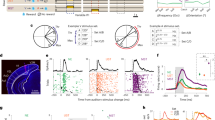Abstract
By recording the magnetic field of the human brain while simultaneously presenting light to the eye and sound to the ear we have identified a brain region where auditory and visual signals converge. The location of this region is close to primary auditory cortex and far from primary visual cortex.
Similar content being viewed by others
References
Gabor D (1946) Theory of communication. J IEEE 93: 429–456
Galaburda A, Sandies F (1980) Cytoarchitectonic organization of the human auditory cortex. J Comp Neurol 190: 597–610
Hari R, Ilmoniemi RJ (1986) Cerebral magnetic fields. CRC Crit Rev Biomed Eng 14: 93–126
Hari R, Lounasmaa OV (1989) Recording and interpretation of cerebral magnetic fields. Science 244: 432–436
Kaufman L, Williamson SJ (1980) The evoked magnetic field of the human brain. Ann NY Acad Sci 340: 45–65
Kaufman L, Williamson SJ (1986) The neuromagnetic field. In: Cracco RQ, Bodis-Wollner I (eds) Evoked potentials. Liss, New York, pp 85–98
Lu ZL, Williamson SI, Kaufman L (1992) Human auditory primary and association cortex have differing lifetimes to activation tests. Brain Res 572: 236–241
Regan D (1989) Human brain electrophysiology. Elsevier, New York
Regan MP, Regan D (1988) A frequency domain technique for characterizing nonlinearities in biological systems. J Theor Biol 133: 293–317
Regan MP, Regan D (1989) Objective investigation of visual function using a nondestructive zoom-FFT technique for evoked potential analysis. Can J Neurol Sci 16: 1–12
Tigges I, Tigges M (1985) Subcortical sources of direct projections to visual cortex. In: Peters A, Jones EG (eds) Cerebral cortex, vol 3. MIT Press, Cambridge, Mass, pp 351–378
Williamson SI, Kaufman L (1981) Biomagnetism. J Magn Magn Mater 22: 129–202
Williamson SJ, Kaufman L (1987) Analysis of neuromagnetic signals. In: Gevins AS, Remond A (eds) Methods of analysis of brain electrical and magnetic signals. Elsevier, Amsterdam, pp 405–448
Williamson SJ, Kaufman L (1989) Advances in neuromagnetic instrumentation and studies of spontaneous brain activity. Brain Topography 2: 129–139
Williamson SJ, Lu L, Karron Z, Kaufman L (1991) Advantages and limitations of magnetic source imaging. Brain Topogr 4: 169–180
Author information
Authors and Affiliations
Rights and permissions
About this article
Cite this article
Regan, M.P., Regan, D. & He, P. An audio-visual convergence area in the human brain. Exp Brain Res 106, 485–487 (1995). https://doi.org/10.1007/BF00231071
Received:
Accepted:
Issue Date:
DOI: https://doi.org/10.1007/BF00231071




